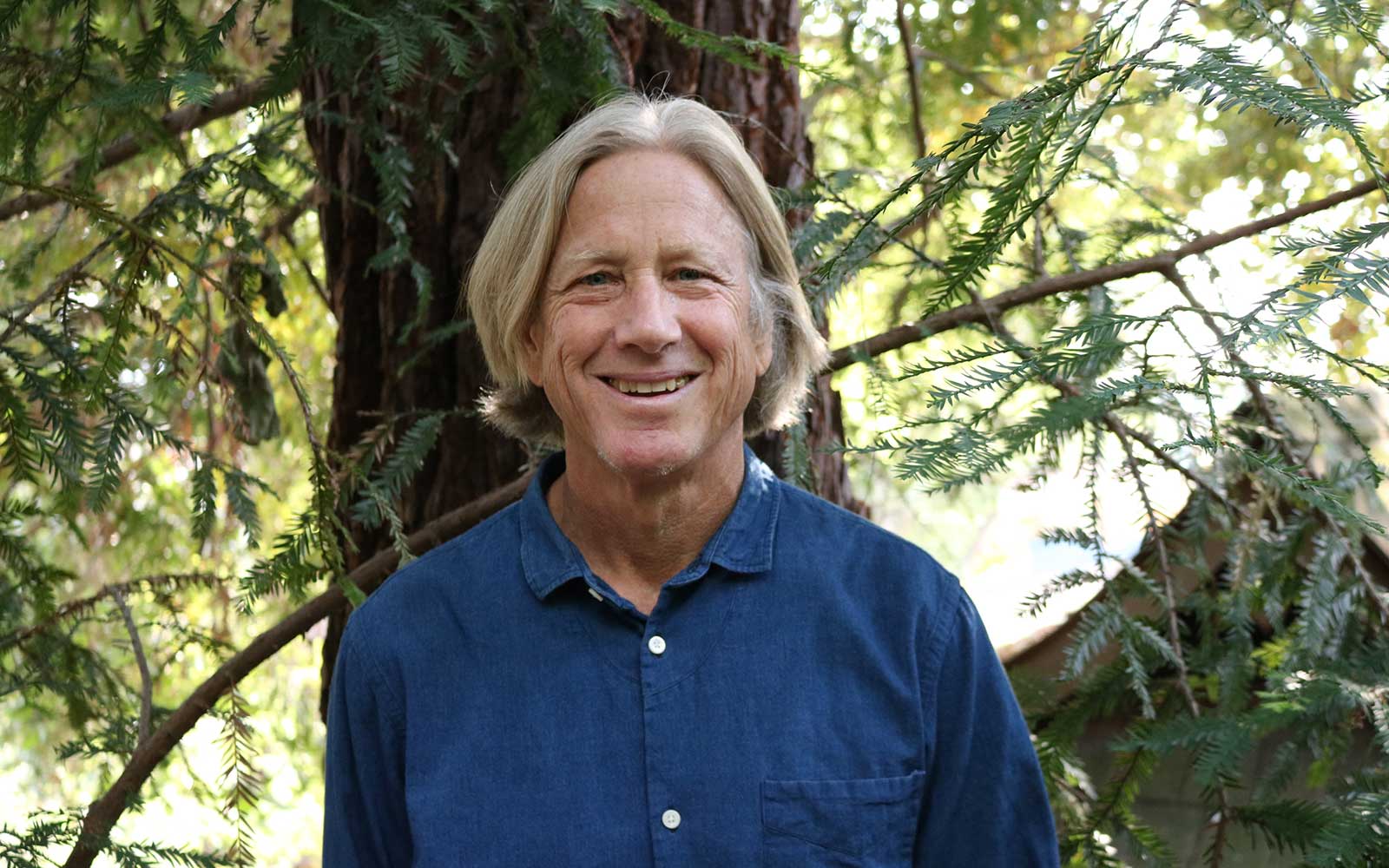Lecture on Compassion: Exploring the new science of self-transcendent emotions
Prominent emotion scientist Dacher Keltner discusses the importance of awe, compassion, and gratitude in our everyday lives

Dacher-Keltner-photo
Photo credit: Natalie Keltner
April 15, 2024
By Grace Strayer
On April 3, the 8th annual Lecture on Compassion, hosted by the Edna Bennett Pierce Prevention Research Center, was filled with compassion, vocal bursts, inhaling and exhaling, and activating the vagal nerve.
Dacher Keltner, distinguished professor of psychology at the University of California, Berkeley, delivered the lecture, titled “The Need to Imagine: How Humans Transcend Reality Through Compassion, Awe, and Aesthetics,” to more than 200 attendees at Penn State and via Zoom. He discussed the study of self-transcendent emotions and their history, their role in everyday life, and their impacts on the human body. Keltner countered the idea that emotions like sympathy are taught via social norms or cultural construction, suggesting that sympathy is part of our evolutionary history and referring to Charles Darwin and his view of sympathy.
Here are some key points that Keltner covered in the lecture:
Vocal Bursts
Keltner and his lab study vocal bursts, the sounds of emotions made by mammals that predate language. According to Keltner, this phenomenon is universal, and brains register and recognize these sounds.
“When we present sympathy to people around the world, they know what the emotion is, those little vocalizations,” Keltner said. “It’s a universal language of caring and compassion.”
Keltner explained that the brain fires within 30 milliseconds of hearing calls of distress, saying, “You don’t even know what you’ve heard, and you’re already orienting towards caring when you hear these little vocal bursts of distress and sympathy.”
The Vagus Nerve and Compassion
The vagus nerve is the largest bundle of nerves in the human body. The vagus nerve partially controls vocalizing, making eye contact, slowing heart rate, and it also affects digestive organs. Exhaling, Keltner explained, activates the vagus nerve.
Further, Keltner shared that in a study done at the University of California, Berkeley, compassion was found to be linked to vagal activity.
“When we get Berkeley students to feel compassion, they show elevated vagus nerve activation,” Keltner said. “Our bodies are wired to care.”
Gratitude
Looking at gratitude, Keltner explained that past research has shown that primates trade grooming for food.
“From my own traditions, I love to see these moral emotions and moral sentiments register in other species,” Keltner added.
To showcase this phenomenon, Keltner had the audience convey different emotions by touching one another’s arms. He explained this activity has been replicated in different parts of the world. Results from his study showed that respondents correctly guessed compassion about 60% of the time and gratitude more than 50% of the time.
Awe
Moving onto awe, Keltner said, “This is a remarkable space of emotion.”
Keltner defines awe as something that you feel when in the presence of something vast and mysterious and that “transcends your current understanding of the world.”
In Keltner’s newest book, “Awe: The New Science of Everyday Wonder and How it Can Transform Your Life,” he identifies eight wonders that bring humans awe, based on his analysis of narratives of awe from 26 countries. These include:
- Mystical Experience, Spirituality
- Ideas
- Nature
- Life and Death
- Moral Beauty
- Visual Design
- Collective Effervescence
- Music
Keltner said, “If we can figure out how to bring more of this into our lives, we’re doing pretty well.”
- According to Keltner, brief experiences of awe can cause these changes:
- Make us more altruistic and less entitled
- Make us feel stronger connections to the community and the natural world
- Increase humility
- Help us see moral conflicts as less polarized
Awe elevates activation of the vagus nerve and reduces inflammation. He stated that so far, awe is the only positive emotion that has been found to reduce inflammation.
“Getting out for a walk on campus, looking at the sky, listening to music, deactivates inflammation,” Keltner said.
Not only has awe been observed deeply throughout history, but it is found to promote a sense of common humanity, according to Keltner.
In a study done with students at Berkeley, Keltner shared that the students who felt awe reported less self-importance, less psychological entitlement, they wanted less money for completing the study, and they were more likely to help pick up dropped pens.
Aesthetics
Keltner also touched on awe as an aesthetic, sharing that culture and relationships influence emotions fundamentally.
Looking at “awe-based design,” Keltner shared an image of La Sagrada Familia, a basilica in Barcelona, Spain made famous by architect Antoni Gaudí, and Keltner said, “We need more awe-based design everywhere.”

The awe-inspiring La Sagrada Familia, in Barcelona, Spain.
Lecture on Compassion: Exploring the new science of self-transcendent emotions
Prominent emotion scientist Dacher Keltner discusses the importance of awe, compassion, and gratitude in our everyday lives

Dacher-Keltner-photo
Photo credit: Natalie Keltner
April 15, 2024
By Grace Strayer
On April 3, the 8th annual Lecture on Compassion, hosted by the Edna Bennett Pierce Prevention Research Center, was filled with compassion, vocal bursts, inhaling and exhaling, and activating the vagal nerve.
Dacher Keltner, distinguished professor of psychology at the University of California, Berkeley, delivered the lecture, titled “The Need to Imagine: How Humans Transcend Reality Through Compassion, Awe, and Aesthetics,” to more than 200 attendees at Penn State and via Zoom. He discussed the study of self-transcendent emotions and their history, their role in everyday life, and their impacts on the human body. Keltner countered the idea that emotions like sympathy are taught via social norms or cultural construction, suggesting that sympathy is part of our evolutionary history and referring to Charles Darwin and his view of sympathy.
Here are some key points that Keltner covered in the lecture:
Vocal Bursts
Keltner and his lab study vocal bursts, the sounds of emotions made by mammals that predate language. According to Keltner, this phenomenon is universal, and brains register and recognize these sounds.
“When we present sympathy to people around the world, they know what the emotion is, those little vocalizations,” Keltner said. “It’s a universal language of caring and compassion.”
Keltner explained that the brain fires within 30 milliseconds of hearing calls of distress, saying, “You don’t even know what you’ve heard, and you’re already orienting towards caring when you hear these little vocal bursts of distress and sympathy.”
The Vagus Nerve and Compassion
The vagus nerve is the largest bundle of nerves in the human body. The vagus nerve partially controls vocalizing, making eye contact, slowing heart rate, and it also affects digestive organs. Exhaling, Keltner explained, activates the vagus nerve.
Further, Keltner shared that in a study done at the University of California, Berkeley, compassion was found to be linked to vagal activity.
“When we get Berkeley students to feel compassion, they show elevated vagus nerve activation,” Keltner said. “Our bodies are wired to care.”
Gratitude
Looking at gratitude, Keltner explained that past research has shown that primates trade grooming for food.
“From my own traditions, I love to see these moral emotions and moral sentiments register in other species,” Keltner added.
To showcase this phenomenon, Keltner had the audience convey different emotions by touching one another’s arms. He explained this activity has been replicated in different parts of the world. Results from his study showed that respondents correctly guessed compassion about 60% of the time and gratitude more than 50% of the time.
Awe
Moving onto awe, Keltner said, “This is a remarkable space of emotion.”
Keltner defines awe as something that you feel when in the presence of something vast and mysterious and that “transcends your current understanding of the world.”
In Keltner’s newest book, “Awe: The New Science of Everyday Wonder and How it Can Transform Your Life,” he identifies eight wonders that bring humans awe, based on his analysis of narratives of awe from 26 countries. These include:
- Mystical Experience, Spirituality
- Ideas
- Nature
- Life and Death
- Moral Beauty
- Visual Design
- Collective Effervescence
- Music
Keltner said, “If we can figure out how to bring more of this into our lives, we’re doing pretty well.”
- According to Keltner, brief experiences of awe can cause these changes:
- Make us more altruistic and less entitled
- Make us feel stronger connections to the community and the natural world
- Increase humility
- Help us see moral conflicts as less polarized
Awe elevates activation of the vagus nerve and reduces inflammation. He stated that so far, awe is the only positive emotion that has been found to reduce inflammation.
“Getting out for a walk on campus, looking at the sky, listening to music, deactivates inflammation,” Keltner said.
Not only has awe been observed deeply throughout history, but it is found to promote a sense of common humanity, according to Keltner.
In a study done with students at Berkeley, Keltner shared that the students who felt awe reported less self-importance, less psychological entitlement, they wanted less money for completing the study, and they were more likely to help pick up dropped pens.
Aesthetics
Keltner also touched on awe as an aesthetic, sharing that culture and relationships influence emotions fundamentally.
Looking at “awe-based design,” Keltner shared an image of La Sagrada Familia, a basilica in Barcelona, Spain made famous by architect Antoni Gaudí, and Keltner said, “We need more awe-based design everywhere.”

The awe-inspiring La Sagrada Familia, in Barcelona, Spain.








